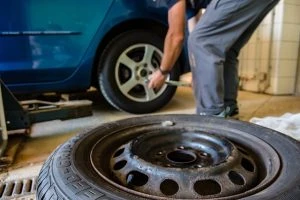How To Change A Flat Tyre

Sometimes, it pays to go back to basics. After all, everybody has to learn the basics some time! There is a common breakdown that you should be able to manage yourself: a puncture in the tyre. With a little bit of prior knowledge, this scenario (which is more common than you might think) can be tackled confidently. If you have the original manual that came with your car when it was first bought from a dealer, then this booklet will have a set of instructions to follow so that you can familiarise yourself with the process of putting a spare tyre on. However, here is the general procedure for changing a wheel.
First of all, let’s figure out how to jack up the vehicle safely. Knowing how to properly jack up the car safely is useful for changing a flat tyre and also for doing simple inspections to wheel bearings and brakes. Jacks are used to get a vehicle off the ground. Now, a word of warning here would be that if you are going to get underneath the car and have a look while the car has been jacked up off the ground, then you must place jack stands in place to hold the weight of the vehicle. This is because if the jack fails or the car is knocked off balance, then the stands will hold the vehicle up, and you won’t get squished. I get claustrophobic enough going under a car even with the jack stands in place so the thought of doing it without is – bleught!
When you jack up the vehicle so that you can work or inspect underneath it, ensure that the vehicle’s handbrake is on, that the vehicle is in first gear (manual transmission) or in park (automatic transmission), that the wheels are chocked, and the jack stands are in place. For changing a tyre, providing the vehicle is on level ground, the handbrake is on, and the car is placed in gear, the jack will take the weight for the duration of changing the wheel. Just don’t go clambering underneath the car!
Here is the method to follow:
- Secure the vehicle so that it won’t roll (check this rather than assuming – slopes can catch you out in odd places).
- Jack up the vehicle. For changing a wheel that has a punctured tyre, I suggest you jack up the vehicle after loosening the lug nuts a little bit with the wrench provided in the vehicle puncture repair kit. Before loosening the nuts, you will need to remove the wheel cover or hubcap. You can do this by using a screwdriver or the flat end of the wheel lug’s nut wrench to lever the cover or hubcap. The reason for loosening the nuts now is because if it is the front wheel that needs replacing, it will spin freely once it loses contact with the ground as you apply torque to undo the lug nuts. You loosen the lug nuts by turning them counterclockwise (the old lefty loosey–righty tighty rule). The lug nuts will and should be fairly tight and will require plenty of torque to remove. After just loosening the nuts, jack up the vehicle completely.
- Now remove the lug nuts completely. Remove the wheel with the punctured tyre.
- Put on the spare, repaired, or new tyre/wheel. Torque up the lug nuts by hand till they are snug to the rim, then lower the car down till the tyre on the wheel makes solid contact with the ground. Now you can tighten the lug nuts all the way without the wheel spinning. Lower the car down completely.
- Put the jack and tools away.
- Drive away.
Yes, it’s that simple. If your car comes with a space saver spare tyre, your drive should be to the nearest tyre centre to get a new full-size one to replace the punctured one. Otherwise, you’re good to go. But make sure that you get a replacement for the punctured tyre. After all, the worst thing when you need to change a punctured tyre is to find an old flat tyre in the compartment instead of a nice new one.